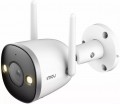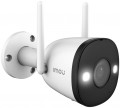Number of LEDs
The number of backlight LEDs (see "Design and capabilities") provided in the camera design.
Theoretically, more LEDs provide more power and, accordingly, range (see below) and efficiency
of IR illumination or LED illumination. However, in fact, such light sources can vary markedly in performance; in addition, a lot also depends on the features of the camera itself. Therefore, in fact, this indicator is a reference, and when choosing, it makes sense to pay attention to parameters that are closer to practice — in particular, the same backlight range (see below).
Smart features
Functions that automate the process of video monitoring, analysis and response to events, which helps to minimize the human factor and increase the efficiency of video surveillance systems.
—
Perimeter protection. This option is used when deploying complex video surveillance systems with a recorder and cameras, combining the expanded functionality of intelligent video analytics capabilities for monitoring boundaries. Perimeter protection can cover various functions, for example, tracking the intersection of virtual lines, the appearance or disappearance of objects in the frame, setting up protected zones, if the boundaries of which are violated, an alarm will be activated, and so on. The full list of features should be specified separately. It is important to note that for the listed functions, analysis of objects in the frame can be used - detection of people, classification of vehicles, etc.
—
Definition of a person. Cameras with this function can detect the presence of people in the frame by the characteristic outlines of their silhouettes. Once a person's presence is detected, an alarm can be activated, and moving PTZ cameras can follow people in the frame.
—
Definition of a car. The ability of a video surveillance camera to automatically recognize and highlight objects in the frame that are vehicles. This can be useful for monitoring t
...raffic, controlling parking, or ensuring the safety of roads within a controlled perimeter. A more advanced implementation of this function is license plate recognition (see below).
— Definition of animal. The function of identifying various “living creatures” in the frame: pets, neighbor’s cats and dogs, alien wild animals, etc. Video surveillance systems with this functionality can be used to minimize false alarms, monitor pets to make sure they are safe and in order, and to solve other similar problems.
— License plate recognition. Special tools that provide additional capabilities for reading license plates. The specific capabilities of such tools may be different in different models; they should be clarified separately. So, some cameras only read letters and numbers and transmit the information to the recorder for further processing. Others have built-in databases, so they can compare the read number with the base and provide various actions depending on the result - for example, send a signal to open the barrier if the number is “allowed”. However, in any case, cameras with this feature are well suited for objects where it is necessary to control the movement of cars - for example, parking lots (including closed service ones).
— Facial recognition. Cameras with this function are able to at least recognize the presence of faces in the frame; but the further use of this data and the special functionality of such cameras may be different. Thus, relatively simple models react only to the very fact of detecting a face, but even this provides quite extensive additional capabilities: focusing on a face, tracking a person in the frame (in moving PTZ cameras), etc. And more advanced cameras can recognize characteristic features faces by which a specific person can be identified. This functionality, among other things, allows the surveillance system to compare the faces “seen” by the camera with the stored database and take various actions based on this - for example, allow or deny access, warn about an unwanted visitor or unauthorized use of a key card, etc. P.
Note that face recognition tools can also be found in recorders to which cameras are connected. However, the presence of such functions in the cameras themselves can also be useful - especially if the existing recorder “does not shine with capabilities” in this regard, or the system does not have a recorder at all (for example, it consists of IP cameras connected via a router to a PC).
— People counting. A function that allows the camera to count the number of people in the frame; the received data is stored in its own memory and can be sent to a recorder or other external device. Note that in most models this feature is combined with the face recognition described above, thanks to which the camera is able not only to count all people in a row, but to recognize tech who are in the frame again. However, people counting can be used for both statistical and security purposes. For example, at large facilities such as office and shopping centers, it allows you to determine whether all visitors who entered the premises left it before the end of working hours.Matrix size
The size of the matrix installed in the surveillance camera (diagonally).
In general, larger sensors (with the same resolution and sensor type) are considered more advanced: they get more light, which has a positive effect on image quality (especially in low light). On the other hand, increasing the size affects the cost of the entire device; and in some cases (for example, if the camera is not planned to be used in twilight and darkness), a relatively small sensor may be quite suitable.
As for specific dimensions, the most modest cameras in terms of this indicator have matrices of
1/4 "or less. Models with sensors of
1/3.8" - 1/3" and
1/2.9" - 1/2" are very popular, these values can be called average. And in advanced devices, diagonals and
more than 1/2 "(up to 1/1.7") are found.
Aperture
Aperture of the lens installed in the camera.
Aperture characterizes the degree of attenuation of the light flux when passing from the front lens of the lens to the matrix. It is denoted as the ratio of the diameter of the active aperture of the lens to the focal length, while the size of the active aperture is designated as f and is taken as a unit — for example, f / 1.4 or f / 2.0. Moreover, the smaller the number in the designation, the higher the aperture (in our example, the second lens will be darker than the first). And for lenses with a variable focal length (see "Focal"), the actual aperture, usually, changes with a change in focal length; for such models, either the range of aperture values, or its maximum value, can be indicated.
By itself, this parameter characterizes, first of all, how light the image taken through the lens turns out, all other things being equal. High values are important, first of all, when shooting in low light conditions: a fast lens allows you to get a fairly high-quality image without increasing the sensitivity of the matrix, which is fraught with noise and “blurring” of the picture. On the other hand, the actual quality of camera operation (including in dark conditions) also depends on many other factors — the type and size of the matrix, signal processing features, etc. Therefore, aperture in most cases is more of a reference than a practically significant parameter.
Horizontal viewing angle
Horizontal viewing angle of the surveillance camera. For models with a variable value, the maximum value is indicated, since it is the width of the image that is important, and when zooming in, the zoom factor is more important than the angle. This paragraph also indicates the general angle of view for models with a circular field of view – in particular, cameras with a fisheye lens (see above)
The wider the viewing angle, the more space the camera captures and at the same time, the smaller the images of individual objects in the frame are obtained. Therefore, when choosing by this parameter, it is worth deciding what is more important – the ability to view a large scene or the visibility of small details in a relatively narrow field of view. Also note that with a wide field of view (100° or more), characteristic distortions can be observed at the edges of the frame, and the wider the angle, the more pronounced they are. This phenomenon can be eliminated by panoramic shooting (see "Design and features"), but this feature, in turn, complicates and increases the cost of the camera.
Vertical viewing angle
Vertical viewing angle of the surveillance camera. In models with a variable value, the maximum is indicated, and the angle when zooming is not so important.
The wider the viewing angle, the more space the camera captures and at the same time, the smaller the images of individual objects in the frame are obtained. Therefore, when choosing by this parameter, it is worth deciding what is more important – the ability to view a large scene or the visibility of small details in a relatively narrow field of view.
Video compression format
The video compression format used by the camera.
Compression is used to reduce the file sizes of captured video; different technologies can be used for this — the so-called codecs, their list is given in this paragraph. From a practical point of view, compatibility with external recording and playback devices primarily depends on the supported codecs. If you plan to use a computer as a recorder / player, you can ignore this list: modern PCs and laptops usually support a very extensive list of formats, and in extreme cases, the missing codecs can be installed separately. But if we are talking about specialized registrars, individual players (like home media centers), etc. — codec compatibility should be clarified further. So, if the advanced modern
H.265 standard is very widely supported nowadays, then the more specific
H.265+, originally created for surveillance systems, is much less common even in specialized equipment.
Power consumption
The power consumed by CCTV cameras during operation. Knowing the indicator of energy consumption, you can, for example, calculate the battery life of equipment from an uninterruptible power supply or choose a suitable “uninterruptible power supply”. Also, with the support of PoE technology, it is worth considering the power consumption when choosing a PoE switch or PoE adapter.
Material
The main material used in the construction of the camera body.
— Plastic. Inexpensive and at the same time quite practical material. Plastic is light, quite strong (not as strong as metal, but still quite sufficient for most cases), chemically inert (and therefore not susceptible to corrosion and insensitive to moisture), and also has a relatively low thermal conductivity (which provides additional protection for extreme temperature fluctuations). Due to all this, this material is very popular in indoor chambers (see "Usage"). At the same time, it is somewhat less suitable for outdoor work.
— Metal. The main advantage of metal, in comparison with plastic, in the case of surveillance cameras is high strength and reliability. This allows you to use it even for street models that work in difficult conditions and must have a certain anti-vandal resistance (at least not immediately “give up” when trying to break or break). At the same time, such material is much more expensive, and therefore less common.

